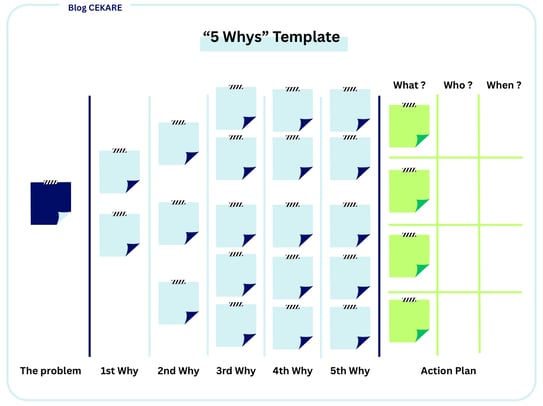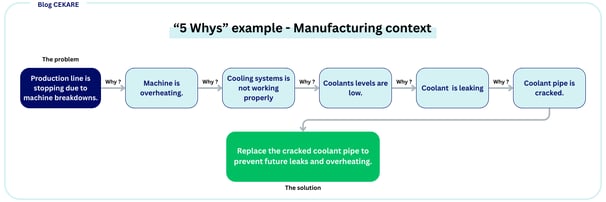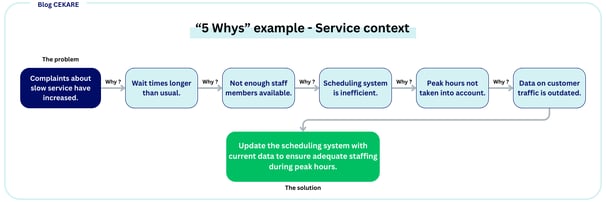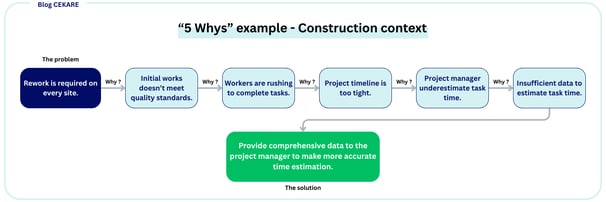Blog CEKARE #5
The "5 Whys" Method
By Baptiste CARRE, 01/05/2025.
Time to read : 5 min


Have you ever faced difficulties tackling problems in your organization ? A simple method exists for you !
One of the most powerful and straightforward techniques for getting to the heart of an issue is the "5 Whys" method. In this article, we'll explore the origins of this method, delve into its benefits, guide you through conducting a "5 Whys" session, and provide concrete examples. By the end, you'll understand how this simple yet effective tool can help you uncover root causes and implement lasting solutions.
SUMMARY
What is the method “5 whys” ?
The “5 Whys” method is based on the simple yet effective idea that by asking "why" five times, you can uncover the root cause of a problem, rather than just addressing its symptoms.
This method was pioneered by Sakichi Toyoda, the founder of Toyota Industries. It is a cornerstone of the Toyota Production System (TPS), which emphasizes eliminating waste and enhancing efficiency. It is considered the basis of the Toyota Scientific approach, by repeating why five times the nature of the problem as well as its solution becomes clear.
To effectively use this method, it is crucial to get as close to the problem as possible. This involves going to the field, observing where and when the issue occurs, understanding what happens before and after, and assessing the consequences.Thorough observation and comprehension of all aspects surrounding the problem will help you accurately identify the root cause.
Imagine you're dealing with a recurring issue in your workplace. Instead of applying a quick fix, the "5 Whys" method encourages you to dig deeper. By asking "why" repeatedly, you peel back the layers to reveal the core issue. This approach has been instrumental in Toyota's success and has since been adopted by countless organizations worldwide.
The Benefits of the "5 Whys" Method.
The "5 Whys" method offers several advantages that make it a go-to tool for problem-solving.
Simplicity
One of the method's greatest strengths is its simplicity. You don't need specialized training or tools to get started. Anyone can ask "why" five times and begin to uncover the root cause of a problem.
Focus on Root Causes
By drilling down to the core issue, the "5 Why" method helps prevent recurrence. Instead of treating symptoms, you address the underlying problem, leading to more sustainable solutions.
Encourages Critical Thinking
This method promotes a culture of inquiry and continuous improvement. It encourages team members to think critically and ask insightful questions, fostering a proactive approach to problem-solving.
Cost-Effective
The "5 Why" method can be implemented quickly and with minimal resources. You don't need expensive software or consultants to get started—just a willingness to ask the right questions.
Versatility
Whether you're in manufacturing, service, healthcare, or any other industry, the "5 Why" method can be applied to a wide range of problems. Its versatility makes it a valuable tool for any organization.
Conducting a "5 Whys" Session.
Ready to conduct your own "5 Why" session? Here are the steps to guide you through the process !


Preparation.
As with every working session, the "5 Whys" require a bit of preparation to be successful.
Here are some elements needed for this session:
Clearly identify the scope of the session, when and where it will be held and how long it will last (also ensure it will not exceed 45 minutes to maintain focus during the session). The closer to the problem, the better.
Prepare a template to take notes and write down all potential causes (take example on our template).
Involve a team with people close to the problem. Those who are working closely to where the problem occurs are the ones with the clearest vision of the problem.
1. Identify the Problem.
Begin by clearly defining the issue you're trying to solve. This is crucial. The problem must be defined precisely and based on facts; avoid making assumptions. Use data and metrics you are monitoring to quantify the problem.
⚠️ Ensure everyone on the team understands the problem statement.
2. Ask "Why" for the first time.
Start by asking why the problem occurred. This first "why" sets the stage for deeper inquiry.
⚠️ Write down every answer directly; do not miss anything.
3. Repeat the exercise 4 more times.
Continue this process by asking "why" four more times. Each "why" will bring you closer to the root cause.
⚠️ Stay factual; answers cannot be based on assumptions.
4. Analyze causes.
Compare all causes to determine which ones have the most impact on the problem, reflecting which ones are the most logical and possible to occur.
⚠️ Put yourself in the situation. Go on the field and compare all potential causes with the live situation.
5. Define countermeasures.
Once you've identified the root cause, develop and implement solutions to address it. This final step ensures that you're not just treating symptoms but solving the underlying issue.
⚠️ Focus on solutions that can be implemented quickly and at low cost.
Follow up
After completing these steps, monitor how the situation improves after implementing the new solutions. If the problem recurs, it may indicate that you didn't ask 'why' enough times.
Some concrete examples !
Let's see the "5 Why" method in action and how flexible this method is with three examples : one from a manufacturing context, one from a service context and one from a construction context.
Manufacturing Context
Problem: A production line is stopping due to machine breakdowns at least once a week.
Why is the production line stopping? Because the machine is overheating.
Why is the machine overheating? Because the cooling system is not working properly.
Why is the cooling system not working properly? Because the coolant levels are low.
Why are the coolant levels low? Because the coolant is leaking.
Why is the coolant leaking? Because the coolant pipe is cracked.
💡 Replace the cracked coolant pipe to prevent future leaks and overheating. By addressing the root cause, you can keep the production line running smoothly.


Service Context
Problem: Customer complaints about slow service have increased by 30%.
Why are customers complaining about slow service? Because the wait times are longer than usual.
Why are the wait times longer than usual? Because there are not enough staff members available.
Why are there not enough staff members available? Because the scheduling system is inefficient.
Why is the scheduling system inefficient? Because it does not account for peak hours.
Why does it not account for peak hours? Because the data on customer traffic patterns is outdated.
💡 Update the scheduling system with current data to ensure adequate staffing during peak hours. By addressing the root cause, you can improve customer satisfaction and reduce complaints.


Construction Context
Problem: Frequent rework is required on every construction site.
Why is frequent rework required? Because the initial work does not meet quality standards.
Why does the initial work not meet quality standards? Because the workers are rushing to complete tasks.
Why are the workers rushing to complete tasks? Because the project timeline is too tight.
Why is the project timeline too tight? Because the project manager underestimated the time required for each task.
Why did the project manager underestimate the time required? Because there was insufficient data from past projects to make accurate estimates.
💡Provide the project manager with comprehensive data from past projects to make more accurate time estimates. By addressing the root cause, you can reduce the need for rework and improve overall project quality.


Conclusion about the "5 Whys".
The "5 Why" method is a valuable tool for any organization looking to improve its problem-solving capabilities. By getting to the root of issues, it helps create lasting solutions and fosters a culture of continuous improvement. If you're facing challenges in your business, consider using the "5 Why" method to uncover the underlying causes and implement effective solutions.
Let's collaborate together to overcome to transform your problems into opportunities.
CEKARE
Boost your operational and industrial performance.
Mail : contact@cekare.eu
Phone : +370 663 58 502
© 2025. All rights reserved.
